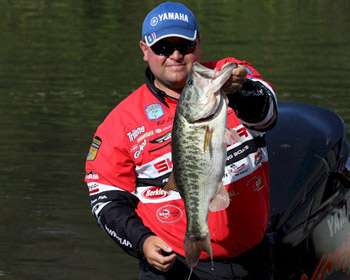
Anglers who have been confined to the house during the winter are now counting the days until spring finally arrives and they can get back out on their favorite lake in pursuit of bass.
However, Elite Series pro Bill Lowen, an acknowledged Ohio "river rat," is quick to point out that lakes and reservoirs are not the only places fishing action will be hot come spring. Lowen has proved repeatedly by his success in tournament competition that creeks and rivers offer anglers some incredible action — particularly during spring.
He cautions, however, that in order to pinpoint the most productive areas of the river, it's best to shy away from the main river channel itself. "The only time that I would even consider fishing the main river in the spring is if all the creeks were 'blown out' by heavy rains, and where water visibility in the creek is virtually nonexistent," Lowen says. While the main river might not be the best bet for early spring action, the creeks and tributaries that feed into the main river often provide the fast action.
"You want to concentrate on the creeks that do not have a defined channel — what I call a 'flat creek,' " says Lowen. "When you get into the creek, it may only be 4 to 6 feet deep in the entire creek, with no defined channel. In early spring, the water in those types of creeks will warm up quickly." Lowen avoids current if at all possible during the spring, focusing instead on the front half of the flat, shallow creeks where there is no current.
He explains that bottom composition is very important in finding the prime areas of the creek or river. "You want to look for the hardest stuff you can find — a gravel bar, a pile of rocks, etc. — some really hard bottom." Cold, muddy water can be a bass angler's Achilles' heel, and rivers are notorious for being just that in most parts of the country during the spring.
Consequently, Lowen steers clear of the muddiest of waters, acknowledging that where river fishing is concerned, water clarity can be relative. "Typically, water clarity depends on how much rain has fallen during the spring," Lowen suggests. "I usually look for a little visibility, but not a lot because typically on a river system you don't have a lot of water clarity.
It's a matter of finding a balance, since you're not usually going to have ultra-clear water in a river, but at the same time you don't want it to be all mud, either." Lowen recommends fishermen concentrate on staying out of the upper ends of creeks and rivers because that's where most of the spring runoff first enters the water body, making the water cooler there. Instead, he concentrates on the lower half of the tributary, where he'll spend most of his days in shallower water (2 to 4 feet), flipping, pitching, shallow cranking, and working spinnerbaits.
"I am also looking for some type of hard cover, whether it is rock or wood, because the fish will want to move up and spawn. In the spring, I don't chase the baitfish." With depth range and water clarity determined, Lowen notes that you're not likely to find bass grouped in schools. "You'll find one or two bass here and there, so it becomes a run-and-gun deal. I'll spend 10 to 20 minutes fishing a stretch of creek channel, and if nothing happens I'll go on to the next one."
By using a run-and-gun approach, Lowen contends that an angler will be better able to determine the areas where the majority of fish will be during the early spring. "The biggest mistake a lot of people make — I see it all the time — is they'll get on a bank and fish it like they are on a lake," Lowen says. "That's just not how you want to fish a river system.
You want to fish specific spots. I call them '10 cast spots' because you pull up and make 10 casts and if you don't get bit, you go to the next spot." Lowen also recommends that anglers stick with heavier tackle when fishing the rivers and creeks during the early spring.
As he points out, "One bite can make the difference between having a good day and having a bad day on a river system."
(Provided by Z3 Media)




